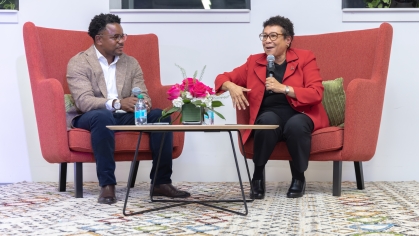New Jazz Web Site Salutes Diplomatic Musical Ambassadors
— The Rutgers University Libraries’ Institute of Jazz Studies announces the launching of the fifth in its ongoing Jazz Greats: Digital Exhibits web series, Jam Session: America’s Jazz Ambassadors Embrace the World, featuring State Department-sponsored tours of jazz musicians between 1956 and 1978. The web site was a joint effort between the Institute and Meridian International Center, a non-profit cultural, arts and educational organization in Washington, D.C., which produced a highly-regarded exhibition by that title last spring and summer. The show, the first deep exploration of the subject and the artists who shared their talents on a global scale, is historic on another level: the subject is deeply rooted in Cold War competition between the United States and the Soviet Union.
The web site should be live by April 1 at http://www.meridian.org/jazzambassadors/ .
“In the cultural exchange arena, the Soviet Union had considerable potency, especially in the areas of classical music and ballet, but the United States had a unique and remarkably effective resource: jazz,” said Dan Morgenstern, director of the Institute of Jazz Studies. “By the time the State Department began to sponsor tours by noted jazz artists, Louis Armstrong had already been dubbed ‘Ambassador Satch,’ and the Voice of America’s ‘Music U.S.A.,’ Willis Conover’s outstanding jazz radio show, had gained thousands of fans for jazz behind the Iron Curtain. Aside from its musical appeal, jazz epitomized democracy in action; not by coincidence, jazz Robinson. And jazz musicians made personal contact with their audiences to a much greater degree than other artists, often to the concern of the authorities. In a fundamental way, jazz was America’s not-so-secret weapon.”
The exhibit and web site focus on five of the most illustrious and active jazz ambassadors: Louis Armstrong, Dave Brubeck, Duke Ellington, Dizzy Gillespie and Benny Goodman. Another section recalls the efforts of George Wein, founder and impresario of the Newport Jazz Festival, who cooperated with the State Department in sending jazz overseas, as well as other tours instigated by the Department. Also included is a 24-page Education Guide prepared by Meridian. The web site will be updated, with the exhibit schedule and other news regarding Jam Session.
Images for the web site came from a number of distinguished cultural institutions and individuals: the Louis Armstrong House and Archives at Queens College; the Dave Brubeck Institute at University of the Pacific; the Smithsonian, home to the Duke Ellington Collection; the Benny Goodman Papers at Yale University; the University of Arkansas at Fayetteville, housing much of the State Department cultural files from the period covered by the jazz tours; the Woody Herman Society; and with Dave Usher of Detroit, a longtime Dizzy Gillespie friend and associate. The main contribution of the Institute came from the files of IJS founder and State Department jazz advisor Marshall Stearns. Stearns had traveled with, lectured for and volunteered as all-around tour guide during the first State Department-sponsored jazz tour, the Dizzy Gillespie Orchestra’s concerts in the Near East in the spring of 1956. Stearns had preserved his lectures and notes, and concert programs and coverage documenting the experience. He also saved his original photographs and negatives that focus primarily on the musician’s non-performing time.
Meridian International Center gave Jam Session a tremendous roll out when the exhibit opened last April. IJS’s Morgenstern was part of a panel discussion that also included pianist Dave Brubeck, who toured for the State Department in 1958 and later, with his wife Iola Brubeck, composed a suite commemorating their experience and saluting the power of jazz in winning friends overseas. Furthermore, IJS media archivist Tad Hershorn did digital restoration of all photographs and other ephemera for the exhibit and wrote an essay on restoring historic images for the web site.
The State Department is planning a multi-year international tour of a scaled-down version of the exhibit, retracing some of the steps of the original tours. Meridian is also scheduling a three-year national tour, including a stop at Jazz@Lincoln Center in New York in February, the first such photographic exhibit in the history of “The Home of Jazz.” In January the show hung in the Rotunda of the Russell Senate Office Building, engaging thousands of excited viewers arriving to pick up their tickets for the Presidential Inauguration the following day.
Other musicians featured in the Jazz Greats Digital Exhibits series, which can be downloaded from the Institute of Jazz Studies web site, include Benny Carter, Mary Lou Williams, Fats Waller and Count Basie.
Media Contact: Tad Hershorn
973 353-5595
E-mail: hershorn@andromeda.rutgers.edu


